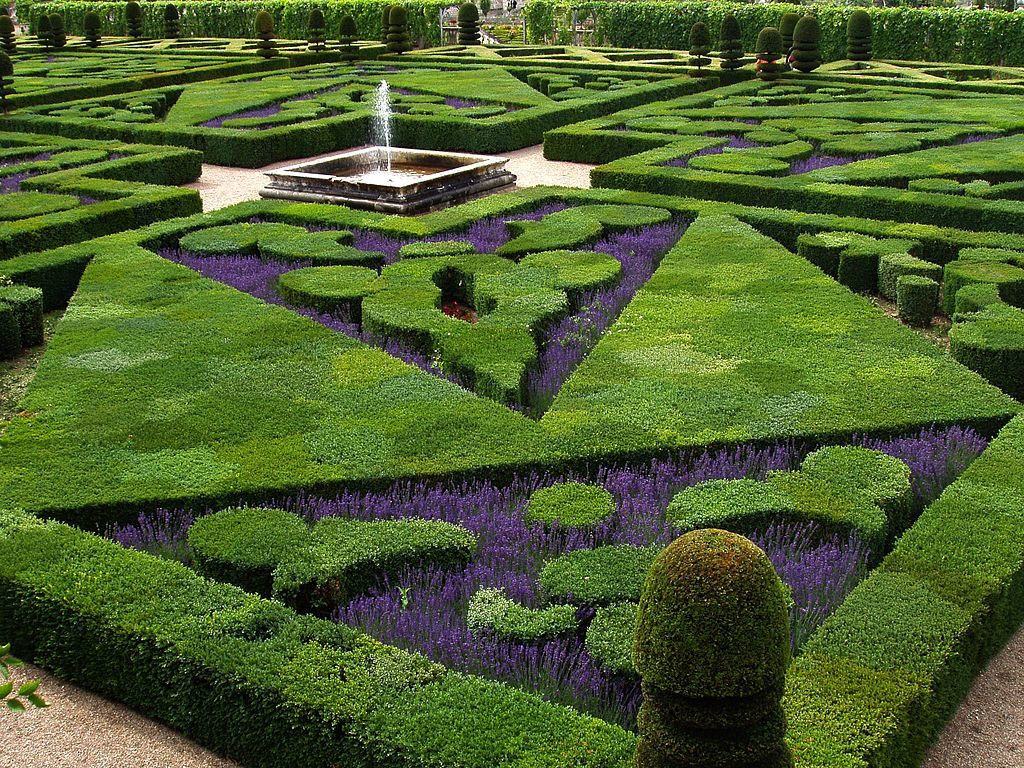
Sun Apr 06 - Written by: Denis Maina
10 Beautiful Garden Layout Ideas; Transform Your Outdoor Space (2025 Guide)
Dreaming of transforming your backyard into a stunning outdoor oasis? A well-planned garden layout can turn even the smallest space into a relaxing retreat you'll love spending time in. Whether you're starting from scratch or giving your existing garden a makeover you'll find inspiration in these creative design ideas.
Your garden’s layout sets the foundation for everything from plant placement to seating areas and pathways. By thinking through the design before you start planting you’ll save time and create a more cohesive outdoor space that works for your lifestyle. We’ve gathered 10 garden layout ideas that combine beauty with functionality to help you plan your perfect backyard paradise.
Understanding Basic Garden Design Principles
Before diving into specific layouts, let’s explore the fundamental principles that’ll help you create a successful garden design.
Analyzing Your Available Space
Start your garden planning by measuring your outdoor space accurately. Grab a measuring tape and sketch out the dimensions of your yard including existing features like trees patios or structures. Note any slopes drainage patterns or problematic areas that might affect plant growth. Consider how you’ll use different zones in your garden such as entertaining spaces vegetable patches or quiet reading nooks. This initial analysis helps you maximize every square foot while creating a balanced functional layout.
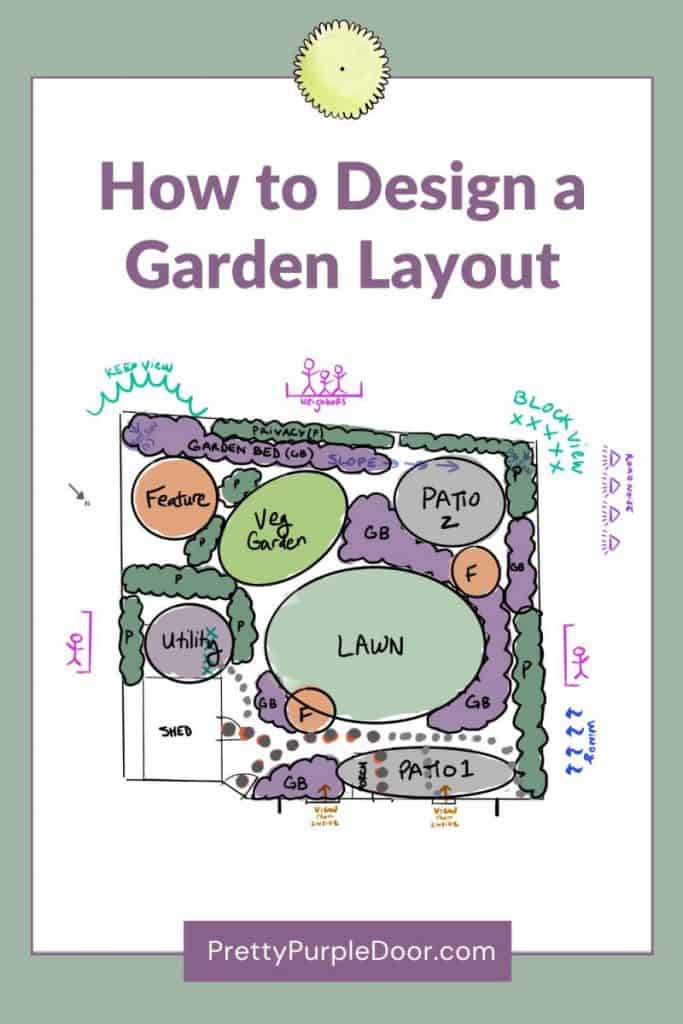 A detailed garden layout sketch showing measurements and different zones for planning purposes. Source: Pretty Purple Door
A detailed garden layout sketch showing measurements and different zones for planning purposes. Source: Pretty Purple Door
Determining Light and Shade Patterns
Track how sunlight moves across your garden throughout the day and across different seasons. Most vegetables need 6-8 hours of direct sunlight while shade-loving plants thrive in areas that get 2-4 hours of filtered light. Use a sun tracking app or simply observe your space at different times: morning noon and late afternoon. Mark sunny partially shaded and fully shaded areas on your garden sketch. This light map becomes your guide for placing plants where they’ll grow best keeping in mind that summer shade patterns will differ from winter ones.
Creating a French-Style Formal Garden Layout
Transform your outdoor space into an elegant French garden with carefully planned geometric designs and perfectly balanced elements.
Symmetrical Bed Arrangements
Create mirror-image planting beds on both sides of a central axis to achieve that classic French garden look. Start by dividing your space into equal sections using string lines or garden hoses to visualize the layout. Place identical plant groupings in matching positions – think boxwood hedges clipped to the same height or matching rose bushes at key focal points. Add structured elements like identical urns or statues on each side to reinforce the symmetry. For the best visual impact position taller plants toward the back of each bed with gradually shorter plants toward the front creating a tiered effect.
 A classic French formal garden showcasing perfect symmetry with meticulously arranged plants and pathways. Source: Eye of the Day Garden Design Center
A classic French formal garden showcasing perfect symmetry with meticulously arranged plants and pathways. Source: Eye of the Day Garden Design Center
Incorporating Geometric Patterns
Use straight lines squares circles and triangles to form eye-catching patterns throughout your garden beds. Start with a simple parterre design by creating box-edged beds filled with gravel or seasonal flowers. Add curved pathways that intersect at right angles to form distinct garden rooms. Include geometric topiaries like cone-shaped shrubs or spiral-cut evergreens as striking focal points. Border your geometric beds with low-growing herbs like lavender or germander to define the shapes clearly. Enhance the patterns with crushed stone or brick pathways that echo the formal design of your planting beds.
Designing a Cottage Garden with Flowing Borders
Transform your garden into a charming cottage-style retreat with flowing borders that break free from rigid structure. This relaxed approach creates a romantic atmosphere while maximizing growing space.
Mixing Flowers and Vegetables
Plant tall flowering perennials like delphiniums and hollyhocks at the back of your borders. Mix in edible plants like rainbow chard tomatoes and climbing beans among traditional cottage flowers such as cosmos zinnias and foxgloves. Layer your plantings with medium-height herbs like sage and lavender in the middle zones. Place compact vegetables like lettuce and compact marigolds along the front edges. This intermingling creates a productive space that’s both beautiful and functional while naturally deterring pests through companion planting.
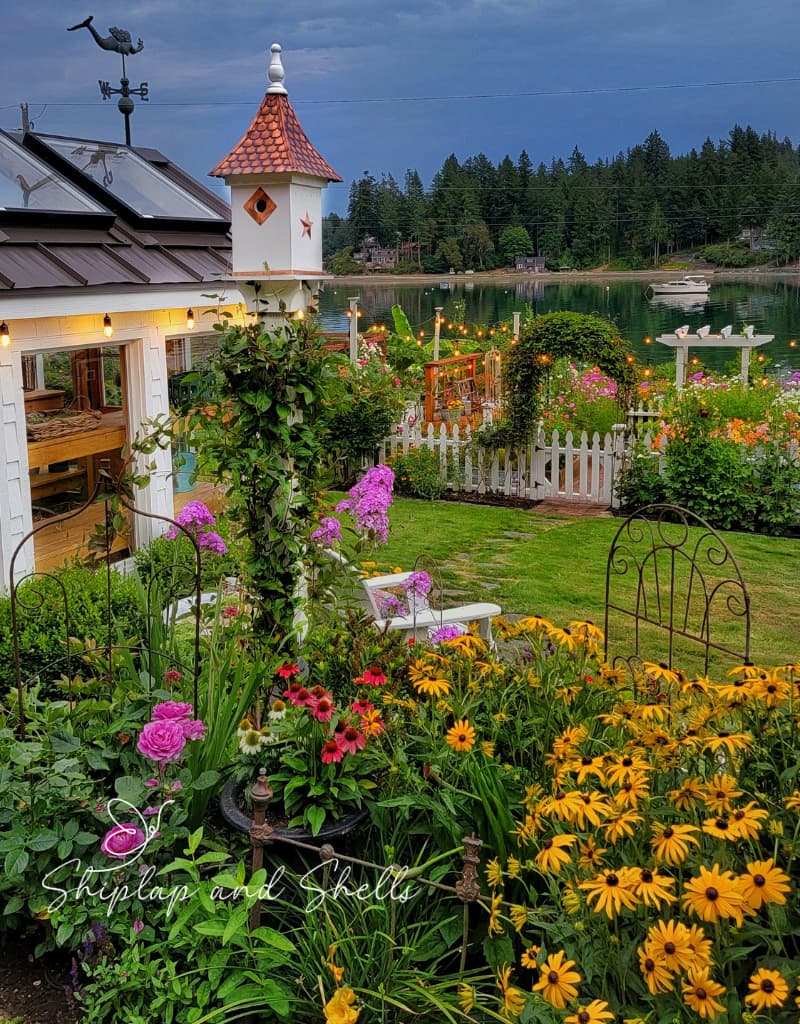 A charming cottage garden with an abundance of flowers creating a lush, informal look with colorful blooms. Source: Shiplap and Shells
A charming cottage garden with an abundance of flowers creating a lush, informal look with colorful blooms. Source: Shiplap and Shells
Creating Natural Pathways
Lay winding paths using informal materials like gravel crushed stone or stepping stones to enhance the cottage garden’s casual feel. Space your pavers irregularly and allow low-growing plants like creeping thyme or chamomile to soften the edges. Let plants spill slightly onto pathways to create that signature cottage garden look where nature seems to rule. Add wooden arbors or rustic gates along your paths to create inviting entrance points. These meandering walkways will guide visitors through your garden while maintaining the relaxed cottage atmosphere.
Planning a Modern Minimalist Garden Space
Transform your outdoor space into a sleek sanctuary by embracing minimalist design principles that focus on essential elements and purposeful simplicity.
Clean Lines and Simple Shapes
Create striking visual impact with geometric patterns and straight edges in your garden layout. Start by dividing your space into clear rectangular or square sections using concrete pavers or metal edging. Opt for raised beds with clean angles and consider installing a simple water feature with straight lines. Choose modern materials like polished concrete charcoal-colored gravel or brushed steel for pathways and borders. Incorporate large square or rectangular planters in monochromatic colors like white charcoal or slate gray to maintain the minimalist aesthetic.
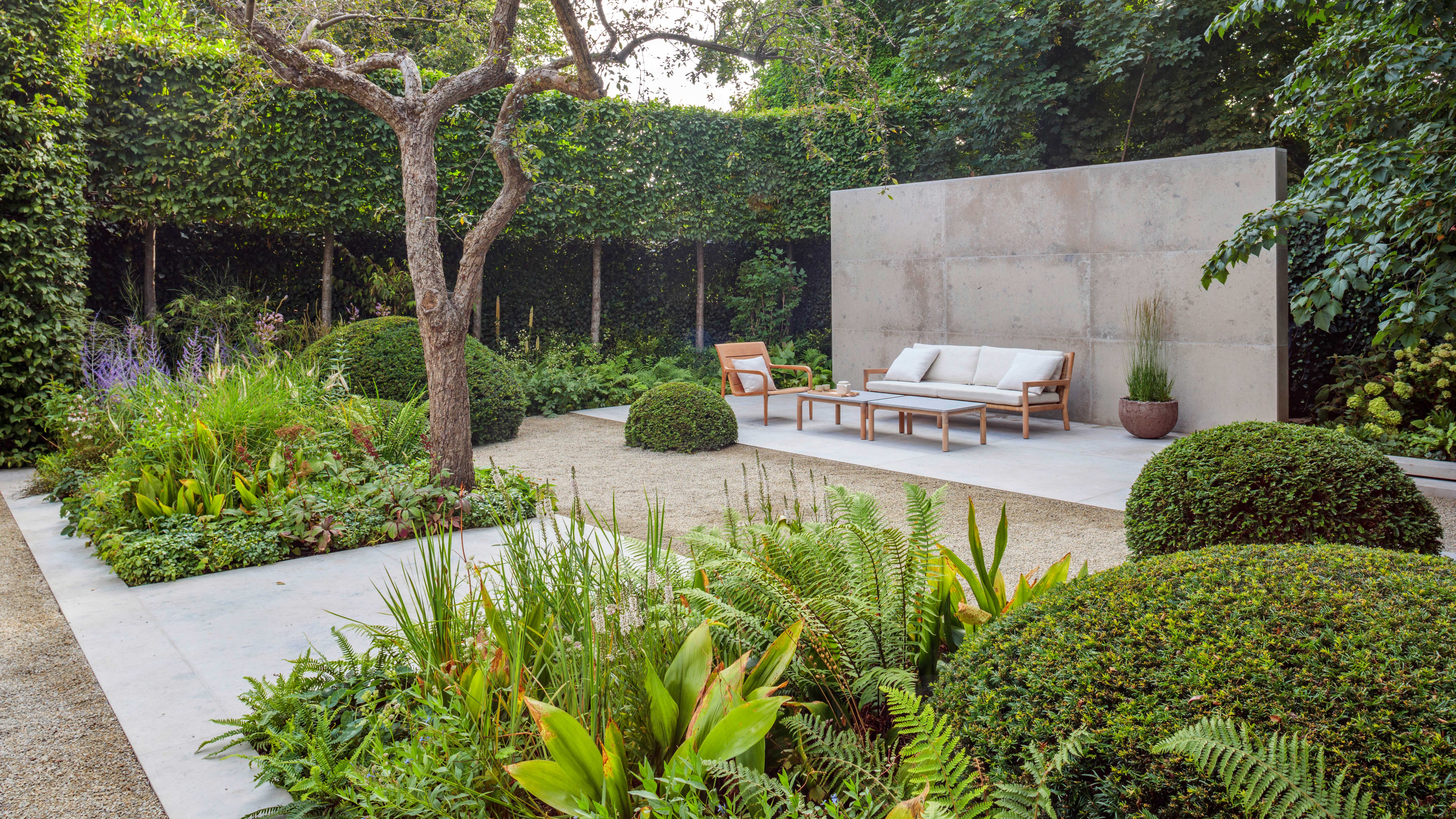 A modern minimalist garden featuring clean lines, simple shapes, and a well-organized layout with strategic plant placement. Source: Homes and Gardens
A modern minimalist garden featuring clean lines, simple shapes, and a well-organized layout with strategic plant placement. Source: Homes and Gardens
Strategic Plant Placement
Select a limited palette of plants to avoid visual clutter focusing on specimens with strong architectural shapes. Group plants in odd-numbered clusters (3 5 or 7) and repeat these groupings throughout the space for visual cohesion. Choose plants with distinctive forms like snake plants bamboo or ornamental grasses that create bold silhouettes. Plant in blocks or grids rather than mixed borders keeping different species separated by clean edges. Add visual interest with varying heights but stick to plants in similar color families preferably in greens silvers or deep purples to maintain the modern look.
Implementing a Kitchen Garden Design
Transform your outdoor space into a productive oasis by creating a well-organized kitchen garden that’s both functional and attractive. This practical approach to gardening lets you grow fresh herbs vegetables and fruits right outside your door.
Raised Bed Configuration
Start your kitchen garden with raised beds in a grid pattern for easy access and maintenance. Choose beds that are 4 feet wide so you can reach the center from either side without stepping into them. Space your beds 2-3 feet apart to create comfortable pathways and arrange them in full sun where your vegetables will thrive. For maximum efficiency create different height beds:
- 6-inch beds for shallow-rooted crops like lettuce and herbs
- 12-inch beds for tomatoes peppers and root vegetables
- 18-inch beds for deep-rooted plants like asparagus
 A well-organized kitchen garden with raised beds arranged in a grid pattern for optimal growing conditions and accessibility. Source: Gardenary
A well-organized kitchen garden with raised beds arranged in a grid pattern for optimal growing conditions and accessibility. Source: Gardenary
Herb Garden Integration
Position your herb garden close to your kitchen door for quick harvesting while cooking. Create designated zones based on herb types:
- Mediterranean section for sun-loving herbs like rosemary thyme and sage
- Shade area for mint parsley and chives
- Annual section for basil cilantro and dill
Install stepping stones between herb patches to prevent soil compaction during harvesting. Group herbs with similar water needs together and consider vertical growing options like wall-mounted planters to maximize space. Add small identifiers or plant markers to help you quickly locate specific herbs when needed.
Crafting a Japanese-Inspired Zen Garden
Transform your outdoor space into a tranquil sanctuary with a Japanese-inspired zen garden design that promotes mindfulness and serenity.
Rock and Gravel Placement
Start your zen garden by laying a foundation of carefully raked gravel or fine sand that represents flowing water. Choose 3-5 large weathered rocks as focal points placing them in asymmetrical groups to mimic natural formations. Position your largest rock at a slight angle to create visual interest then cluster smaller rocks around it following the rule of thirds. Add crushed granite or pebbles in concentric circles around rock groupings using a rake to create ripple patterns. For authentic design incorporate moss-covered stones near shaded areas to add texture and color variation. Keep the space between rock formations open allowing the gravel patterns to flow uninterrupted which helps maintain the garden’s meditative quality.
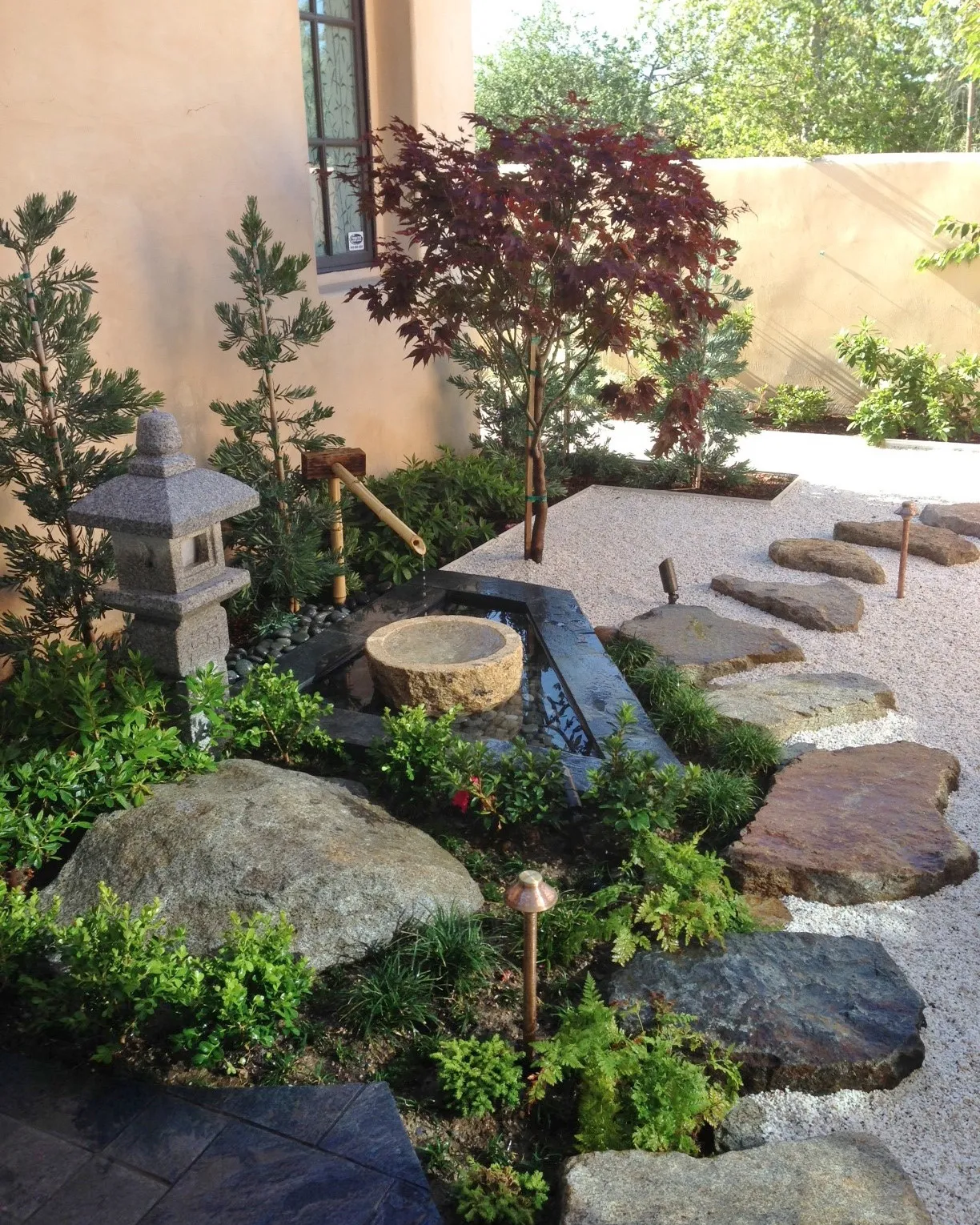 A serene Japanese zen garden featuring carefully placed rocks on a bed of raked white gravel, creating a tranquil meditation space. Source: Southwest Boulder & Stone
A serene Japanese zen garden featuring carefully placed rocks on a bed of raked white gravel, creating a tranquil meditation space. Source: Southwest Boulder & Stone
Water Feature Integration
Add a bamboo water fountain (shishi-odoshi) as your garden’s centerpiece to create gentle sounds that enhance the peaceful atmosphere. Install a small reflecting pool lined with smooth river rocks to mirror the sky and surrounding greenery. Position the water feature where it’s visible from your main viewing area usually a deck or meditation bench. Use shallow streams created with dark river rocks to connect different sections of your garden naturally. Consider adding a tsukubai (washing basin) near the garden entrance which serves both as a decorative element and a traditional purification symbol. Keep water features simple and low-maintenance using recirculating pumps that maintain consistent water flow while conserving resources.
Developing a Wildlife-Friendly Garden Layout
Transform your garden into a thriving ecosystem that attracts birds butterflies and beneficial insects with a wildlife-friendly design.
Native Plant Zones
Create dedicated zones for local native plants to support your region’s wildlife. Group plants by their natural habitat preferences such as sunny meadow woodland edge or wetland areas. Select plants that bloom in different seasons to provide year-round food sources for pollinators. Include native shrubs like viburnum elderberry and dogwood which offer berries for birds. Plant these in clusters of 3-5 specimens to create visible “landing zones” for wildlife. Add native wildflowers like coneflowers black-eyed susans and milkweed to attract butterflies and support their life cycles.
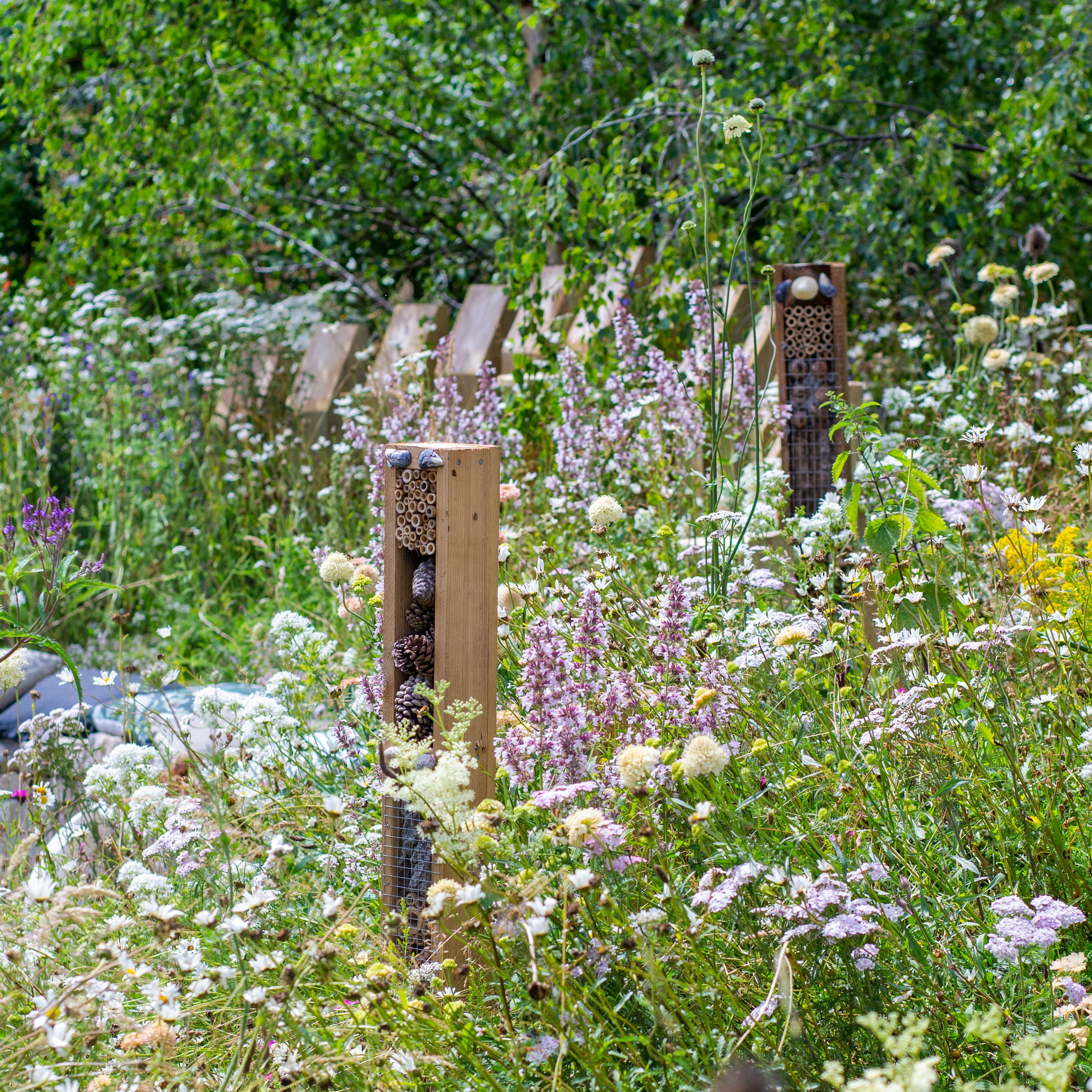 A wildlife-friendly garden filled with native plants that attract pollinators and birds, creating a thriving ecosystem. Source: Homes and Gardens
A wildlife-friendly garden filled with native plants that attract pollinators and birds, creating a thriving ecosystem. Source: Homes and Gardens
Creating Natural Habitats
Design your garden with layers that mimic natural environments. Start with tall trees for nesting sites then add medium shrubs for shelter and ground cover plants for foraging areas. Include a small pond or water feature that’s 2-3 feet deep in the center with gradually sloping sides for easy wildlife access. Create brush piles using fallen branches and leaves in quiet corners to provide shelter for beneficial insects and small animals. Add flat rocks in sunny spots for basking areas and leave some bare soil patches for ground-nesting bees. Position bird feeders and baths near protective shrubs so wildlife feels safe while visiting your garden.
Organizing a Container Garden Design
Transform limited space into a versatile garden oasis with strategic container placement and thoughtful design elements that maximize growing potential while maintaining visual appeal.
Vertical Gardening Solutions
Take your container garden to new heights with smart vertical solutions that multiply your growing space. Install tiered plant stands or repurpose wooden pallets to create living walls packed with herbs succulents or trailing flowers. Mount weatherproof pocket planters on sunny walls or fences to grow compact vegetables like lettuce herbs and strawberries. Stack sleek metal or ceramic containers on industrial pipe shelving for an urban garden look. Use trellises behind large containers to support climbing plants like peas tomatoes or flowering vines creating dynamic layers of greenery. Position taller plants in back graduating to shorter ones in front for optimal sunlight exposure and visual interest.
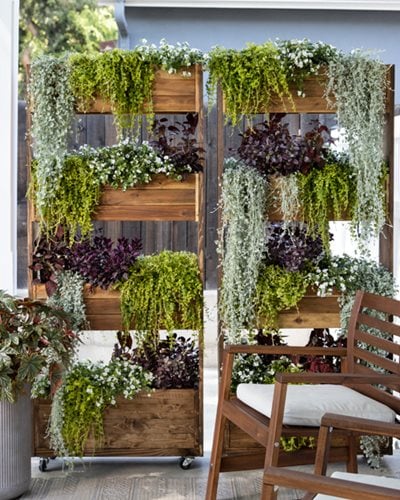 A creative vertical container garden system that maximizes space by growing upward, perfect for small areas like balconies or patios. Source: Garden Design
A creative vertical container garden system that maximizes space by growing upward, perfect for small areas like balconies or patios. Source: Garden Design
Mobile Garden Elements
Make your container garden adaptable with wheels casters or portable plant stands that let you reconfigure the space easily. Place larger containers on rolling plant caddies to chase the sun throughout the day or protect tender plants from harsh weather. Create flexible seating areas with lightweight planters that double as space dividers. Use stackable containers that you can rearrange seasonally based on your plants’ needs. Consider collapsible trellises and modular shelving units that you can move or store when needed. Add wheeled herb gardens near your outdoor dining space for easy access while entertaining. This mobility helps you optimize growing conditions and refresh your garden’s look whenever you want.
Building a Mediterranean-Style Garden
Transform your garden into a sun-drenched oasis inspired by the coastal regions of southern Europe. A Mediterranean garden combines drought-tolerant plants with inviting outdoor living spaces that encourage al fresco dining and relaxation.
Drought-Resistant Plant Groupings
Start your Mediterranean garden with clusters of drought-resistant plants that thrive in full sun and well-drained soil. Group lavender rosemary sage and thyme together to create aromatic herb borders that require minimal watering. Add architectural plants like Italian cypress olive trees and mature agaves to create strong vertical elements. For groundcover use low-growing options like creeping thyme woolly yarrow and silver-leafed artemisia. Include Mediterranean natives such as santolina euphorbias and rock roses for pops of color throughout the growing season. Plant these drought-tolerant varieties in gravelly soil with excellent drainage to prevent root rot and promote healthy growth.
 A Mediterranean-style garden featuring drought-resistant plants in a sunny, well-drained setting with a harmonious blend of textures and colors. Source: Greenhouse Studio
A Mediterranean-style garden featuring drought-resistant plants in a sunny, well-drained setting with a harmonious blend of textures and colors. Source: Greenhouse Studio
Creating Outdoor Living Spaces
Design your Mediterranean garden around a central patio or terrace that serves as an outdoor living room. Install a pergola covered with climbing wisteria or grapevines to provide natural shade during hot afternoons. Create distinct zones using gravel paths bordered by fragrant herbs and ornamental grasses. Add terra cotta pots filled with citrus trees and geraniums to bring life to your seating areas. Include a rustic wooden dining table for entertaining and strategically place weathered urns as focal points. Consider adding a small water feature like a wall fountain to provide gentle sounds and cool refreshment. Use light-colored materials like limestone pavers or whitewashed walls to reflect heat and maintain the authentic Mediterranean feel.
Incorporating Water-Wise Garden Planning
Transform your garden into a sustainable oasis by implementing water-conscious design strategies that reduce water consumption while maintaining beauty.
Xeriscaping Principles
Create a water-efficient landscape by grouping plants with similar water needs into distinct hydrozones. Choose drought-tolerant plants like salvias sedum & ornamental grasses that thrive with minimal irrigation. Replace thirsty lawns with permeable hardscaping materials such as gravel mulch or decomposed granite to reduce water needs. Add a 2-3 inch layer of organic mulch around plants to retain soil moisture & suppress water-hungry weeds. Select native plants adapted to your local climate as they naturally require less supplemental watering once established.
 A water-wise garden demonstrating xeriscaping principles with carefully grouped drought-tolerant plants and efficient use of mulch. Source: High Country Gardens
A water-wise garden demonstrating xeriscaping principles with carefully grouped drought-tolerant plants and efficient use of mulch. Source: High Country Gardens
Efficient Irrigation Layout
Install a smart irrigation system with separate zones for different plant water requirements & sun exposure levels. Use drip irrigation or soaker hoses to deliver water directly to plant roots reducing waste from overspray & evaporation. Position sprinkler heads to avoid watering pathways or structures & adjust them seasonally as sun patterns change. Add a rain sensor to automatically skip watering cycles during wet weather. Schedule irrigation for early morning hours (between 4-6 AM) when wind & evaporation rates are lowest. Connect your system to a smart controller that adjusts watering based on weather data & soil moisture levels.
Bringing Your Garden Design to Life
Start by laying out your garden’s basic framework using string lines and stakes to mark planting areas. Add key hardscaping elements like pathways and patios first, ensuring proper drainage. Install your irrigation system before planting to avoid disturbing roots later. Begin planting larger specimens like trees and shrubs to establish the garden’s structure before adding smaller plants.
 Bringing a garden design to life through careful implementation and planting, creating a foundation for a beautiful outdoor space. Source: Utah Style and Design
Bringing a garden design to life through careful implementation and planting, creating a foundation for a beautiful outdoor space. Source: Utah Style and Design